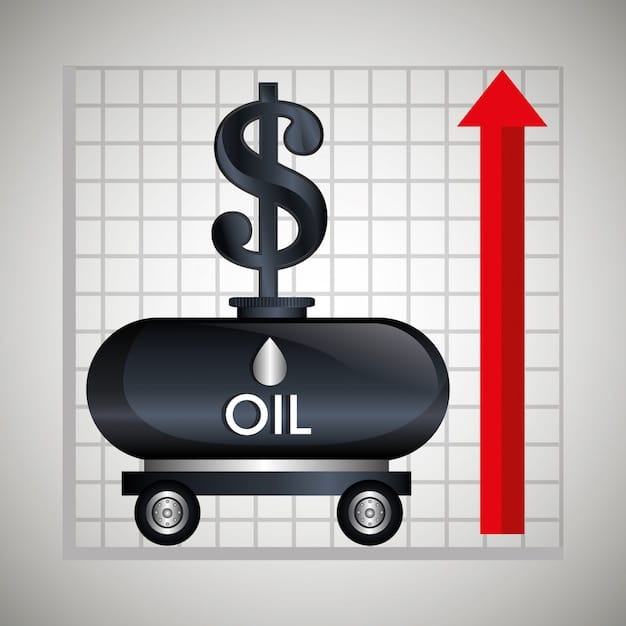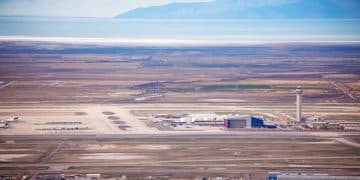Sustainable Aviation Fuel: Can SAF Power 50% of US Flights by 2050?

Sustainable Aviation Fuel (SAF) offers a promising pathway to decarbonize the aviation sector, but whether SAF can power 50% of US flights by 2050 depends on overcoming significant challenges in production, cost, and infrastructure development.
The aviation industry is under increasing pressure to reduce its carbon footprint, and Sustainable Aviation Fuel: Can SAF Power 50% of US Flights by 2050? remains a critical question in the pursuit of eco-friendly air travel.
Understanding Sustainable Aviation Fuel (SAF)
Sustainable Aviation Fuel (SAF) is not just another biofuel; it’s a game-changer designed to drastically reduce the environmental impact of air travel. But what exactly is SAF, and why is it so important?
SAF is a biofuel that can be made from a variety of sustainable feedstocks. These feedstocks include things like used cooking oil, agricultural waste, and even algae. The key difference between SAF and traditional jet fuel is that it has a significantly lower carbon footprint.
The Benefits of SAF
SAF offers numerous benefits that make it a crucial component in the future of aviation. Here are some key advantages:
- Reduced Carbon Emissions: SAF can reduce carbon emissions by up to 80% compared to traditional jet fuel, making it a vital tool in combating climate change.
- Sustainable Feedstocks: The use of waste products and non-food crops as feedstocks ensures that SAF production doesn’t compete with food production or contribute to deforestation.
- Compatibility: SAF is designed to be a “drop-in” fuel, meaning it can be blended with traditional jet fuel and used in existing aircraft without requiring modifications.
Challenges in SAF Production
Despite its promise, SAF production faces several challenges that need to be addressed to scale up its availability:
- Cost: SAF is currently more expensive to produce than traditional jet fuel, which can make it less attractive to airlines.
- Supply: The current supply of SAF is limited, and scaling up production requires significant investment in infrastructure and feedstock development.
- Regulatory Hurdles: Streamlining the regulatory approval process for new SAF production pathways is essential to encourage innovation and accelerate deployment.
In conclusion, Sustainable Aviation Fuel represents a promising solution for reducing the environmental impact of flying. While challenges remain, ongoing efforts to scale up production and reduce costs could pave the way for a more sustainable future for aviation.
Current SAF Production and Use in the US
The current landscape of Sustainable Aviation Fuel (SAF) production and usage in the United States is a mix of pilot projects, limited commercial availability, and ambitious goals. How far has the US come in embracing SAF?
While SAF production is still in its nascent stages, several companies and initiatives are making headway in developing and deploying SAF across the country. These efforts range from establishing new production facilities to partnering with airlines to supply SAF.

Key Players in SAF Production
Several key players are driving the development and production of SAF in the US:
- Neste: A leading producer of renewable fuels, Neste has expanded its SAF production capacity and is supplying SAF to several US airports.
- World Energy: This company operates the first SAF production facility in the world, located in Paramount, California.
- Gevo: Gevo is developing SAF using sustainable agriculture practices and has secured offtake agreements with major airlines.
SAF Blending and Infrastructure
One of the advantages of SAF is its compatibility with existing infrastructure. SAF can be blended with traditional jet fuel and used in existing aircraft without requiring significant modifications.
However, challenges remain in expanding the infrastructure needed to support SAF blending and distribution. Airports need to invest in storage and handling facilities to accommodate SAF, and airlines need to ensure that their aircraft are compatible with SAF blends.
In summary, the US is making strides in SAF production and use, but significant investment and policy support are needed to scale up the industry and achieve ambitious decarbonization goals for the aviation sector.
Policy and Incentives Driving SAF Adoption
Government policies and incentives play a crucial role in driving the adoption of Sustainable Aviation Fuel (SAF). What policies are currently in place, and what impact are they having?
Without supportive policies and incentives, the widespread adoption of SAF would be economically challenging. Governments around the world are implementing various measures to encourage SAF production and use.
The Role of Government Incentives
Government incentives can help to level the playing field between SAF and traditional jet fuel. Several types of incentives are being used to promote SAF adoption:
Tax Credits: Tax credits can reduce the cost of SAF production, making it more competitive with traditional jet fuel. For example, the US has introduced a Blenders Tax Credit for SAF.
- Grants and Subsidies: Grants and subsidies can help to finance the construction of SAF production facilities and support research and development activities.
Government policies and incentives are critical for driving the adoption of SAF. By creating a supportive regulatory and economic environment, governments can help to scale up the SAF industry and accelerate the decarbonization of the aviation sector.
Challenges to Widespread SAF Use
While Sustainable Aviation Fuel (SAF) holds incredible promise, several challenges stand in the way of its widespread adoption. What are these hurdles, and how can they be overcome?
SAF faces significant difficulties related to cost, feedstock availability, technological advancements, and infrastructure constraints. Overcoming these challenges requires coordinated efforts from governments, industry stakeholders, and researchers.

Economic Viability
The high cost of SAF compared to conventional jet fuel is one of the most significant barriers to its widespread adoption. SAF production processes are often more complex and energy-intensive, leading to higher production costs.
- Feedstock Limitations: Ensuring a sustainable and reliable supply of feedstocks is essential for SAF production. However, the availability of suitable feedstocks can be limited by factors such as land use constraints, competition with other industries, and environmental considerations.
Technological and Infrastructure Challenges
The development of new SAF production technologies and the expansion of infrastructure to support SAF blending and distribution are both critical for widespread adoption.
In conclusion, addressing these challenges requires a multi-faceted approach that includes policy support, technological innovation, industry collaboration, and consumer engagement. By working together, stakeholders can overcome these hurdles and unlock the full potential of SAF to reduce aviation’s environmental impact.
The Path to 50% SAF Usage by 2050
Achieving 50% Sustainable Aviation Fuel (SAF) usage in US flights by 2050 is an ambitious goal that requires a concerted effort across various sectors. What are the key steps to reaching this target?
The path to 50% SAF usage will involve a combination of technological advancements, policy support, investment in infrastructure, and collaboration among stakeholders. A clear roadmap with measurable milestones is essential to keep progress on track.
Scaling Up SAF Production
One of the most important steps is to significantly increase SAF production capacity. This will require investment in new production facilities and the development of innovative technologies that can produce SAF more efficiently and cost-effectively.
- Feedstock Diversification: Expanding the range of sustainable feedstocks used for SAF production can help to increase feedstock availability and reduce the environmental impact of SAF production.
Policy and Market Mechanisms
Supportive government policies and market mechanisms are essential for creating a level playing field between SAF and conventional jet fuel. These policies can include tax credits, subsidies, and mandates that require airlines to use a certain percentage of SAF.
In summary, achieving 50% SAF usage by 2050 is a challenging but achievable goal. By focusing on scaling up production, reducing costs, fostering collaboration, and engaging consumers, the aviation industry can transition towards a more sustainable future.
Future Innovations in Sustainable Aviation
The future of sustainable aviation extends beyond current Sustainable Aviation Fuel (SAF) technologies. What innovative approaches are on the horizon to further reduce aviation’s environmental impact?
The quest for more sustainable air travel is driving innovation across various fields, including fuel production, aircraft design, and operational practices. Bold thinking and technological breakthroughs will be essential for achieving long-term sustainability in the aviation industry.
Alternative Fuel Technologies
Researchers are exploring a variety of alternative fuel technologies that could potentially replace or complement SAF. These include:
- Hydrogen: Hydrogen fuel cells offer the potential for zero-emission flights.
- Synthetic Fuels: Synthetic fuels are produced from renewable energy sources.
Aircraft Design and Efficiency
In addition to alternative fuels, innovations in aircraft design and operational efficiency can significantly reduce aviation’s environmental impact.
- Electric Aircraft: Electric aircraft are ideal for short-haul flights.
- Sustainable Designs: New shapes and materials that reduce fuel consumption.
In conclusion, the future of sustainable aviation is ripe with possibilities. By fostering innovation, embracing emerging technologies, and pursuing collaborative solutions, the aviation industry can continue to reduce its environmental impact and contribute to a more sustainable future for air travel.
| Key Point | Brief Description |
|---|---|
| 🌱 SAF Definition | Biofuel reduces carbon footprint drastically. |
| 💰 Cost Barriers | SAF is more expensive than jet fuel. |
| 🏭 US Production | Projects and commercial viability are being implemented. |
| ✈️ Policy Impact | Governmental policies incentivize SAF use. |
Frequently Asked Questions (FAQ)
▼
Sustainable Aviation Fuel (SAF) is a biofuel used to power aircraft with a smaller carbon footprint than standard jet fuel. These fuels are made from sustainable sources like waste matter, certain plants, and algae.
▼
SAF is a pivotal component in aviation’s sustainability efforts, significantly reducing greenhouse gas emissions. Given SAF works with current airline tech, adopting this offers a more eco-friendly flight approach.
▼
Expanded SAF use hits hurdles like a larger price tag, limited supply levels, and tricky production. These challenges make competing with regular jet fuel more difficult. It also requires significant infrastructure upgrades.
▼
Policy support includes tax breaks, subsidies, and mandates for SAF’s integration into airline operations. Supportive policy efforts help mitigate SAF’s costs as well as incentivizes more widespread environmental practices.
▼
In aviation, several innovations can enhance sustainability, like hydrogen fuel, electric aircraft designs, and advanced biofuels. The development and use of new carbon-neutral technology is also a good practice.
Conclusion
In conclusion, the journey toward powering 50% of US flights with Sustainable Aviation Fuel by 2050 presents both immense opportunities and significant challenges. Overcoming these hurdles requires collaboration across government, industry, and research sectors to foster technological innovation, drive down costs, and ensure a sustainable future for air travel.





